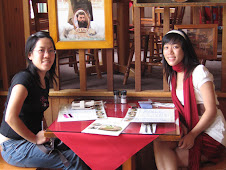the chinese medium - tang ki
when i was young, i was in awe of the tang-ki, the chinese spirit medium, especially the men who could perform feats which would have normally maim them but when they came out of the trances, they always appeared none the worse for it. in the neighbouring kampong, at lorong sinaran, there was this small taoist temple which would stage chinese wayang once at year.
that was also when the tang-ki would be performing in the open for all to see. first, the man, usually in their thirties or forties, would sit in a special chair before the altar. he would subsequently go into a trance invoking the power of deities like the boy god no-cha or the much loved monkey god.
all the implements for inflicting cuts and wounds, like the sword, skewers, iron spike ball and whip, would be placed on the table before him. once he got into the trance stage, he would start speaking in a strange tongue. ordinary people like us normally had no idea what he was mumbling but his assistants were able to take his instructions.
usually, he would start by using the big and thick jute whip to make smacking noises by hitting it hard on the ground or floor. as he was doing this, he would be skipping around, shaking his head and making strange utterances. at the same time, there would be accompaniment by a drummer using a hand-held drum and a shallow gong player. as the medium got more agitated, the two players would increase the tempo to a crescendo.
he would then turn the whip on himself, expertly lashing his own back. following this, he might request his assistant to hand him the sword or the spike ball. with the sword, he would use it to inflict cuts on his back, in a somewhat controlled way, till you could see cut lines and blood oozing out. sometimes he would return to sit on the chair and use the sword to cut his tongue.
i have seen the spike ball used in only one way. the tang-ki would hold the handle and hit his own bare back with the spike ball. when the medium was going to work on his back, his assistant would take a gulp of blessed water in his mouth and sprayed the water on the medium's back. the medium would also take a mouthful of blessed water from a bowl and sprayed it on the blade of the sword before starting to use it on his back.
on bigger festive occasions, there were instances when two or more tang-kis performed at the same time.
these days, i am no longer intrigued by these demonstrations of spiritual powers.

























































